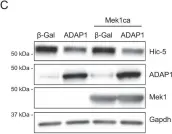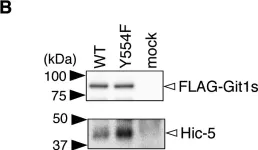Integrins are fundamental for cell adhesion and the formation of focal adhesions (FA). Accordingly, these receptors guide embryonic development, tissue maintenance, and haemostasis but are also involved in cancer invasion and metastasis. A detailed understanding of the molecular interactions that drive integrin activation, FA assembly, and downstream signalling cascades is critical. Here, we reveal a direct association of paxillin, a marker protein of FA sites, with the cytoplasmic tails of the integrin β1 and β3 subunits. The binding interface resides in paxillin's LIM3 domain, where based on the NMR structure and functional analyses, a flexible, 7-amino acid loop engages the unstructured part of the integrin cytoplasmic tail. Genetic manipulation of the involved residues in either paxillin or integrin β3 compromises cell adhesion and motility of murine fibroblasts. This direct interaction between paxillin and the integrin cytoplasmic domain identifies an alternative, kindlin-independent mode of integrin outside-in signalling particularly important for integrin β3 function.
Copyright: © 2024 Baade et al. This is an open access article distributed under the terms of the Creative Commons Attribution License, which permits unrestricted use, distribution, and reproduction in any medium, provided the original author and source are credited.
Product Citations: 33
A flexible loop in the paxillin LIM3 domain mediates its direct binding to integrin β subunits.
In PLoS Biology on 1 September 2024 by Baade, T., Michaelis, M., et al.
-
WB
Paxillin phase separation promotes focal adhesion assembly and integrin signaling.
In The Journal of Cell Biology on 1 April 2024 by Liang, P., Wu, Y., et al.
Focal adhesions (FAs) are transmembrane protein assemblies mediating cell-matrix connection. Although protein liquid-liquid phase separation (LLPS) has been tied to the organization and dynamics of FAs, the underlying mechanisms remain unclear. Here, we experimentally tune the LLPS of PXN/Paxillin, an essential scaffold protein of FAs, by utilizing a light-inducible Cry2 system in different cell types. In addition to nucleating FA components, light-triggered PXN LLPS potently activates integrin signaling and subsequently accelerates cell spreading. In contrast to the homotypic interaction-driven LLPS of PXN in vitro, PXN condensates in cells are associated with the plasma membrane and modulated by actomyosin contraction and client proteins of FAs. Interestingly, non-specific weak intermolecular interactions synergize with specific molecular interactions to mediate the multicomponent condensation of PXN and are efficient in promoting FA assembly and integrin signaling. Thus, our data establish an active role of the PXN phase transition into a condensed membrane-associated compartment in promoting the assembly/maturation of FAs.
© 2024 Liang et al.
-
ICC-IF
-
Cell Biology
In The Journal of Biological Chemistry on 1 February 2024 by Fang, M., Liu, X., et al.
Many metabolic diseases are caused by disorders of lipid homeostasis. CIDEC, a lipid droplet (LD)-associated protein, plays a critical role in controlling LD fusion and lipid storage. However, regulators of CIDEC remain largely unknown. Here, we established a homogeneous time-resolved fluorescence (HTRF)-based high-throughput screening method and identified LPXN as a positive regulatory candidate for CIDEC. LPXN and Hic-5, the members of the Paxillin family, are focal adhesion adaptor proteins that contribute to the recruitment of specific kinases and phosphatases, cofactors, and structural proteins, participating in the transduction of extracellular signals into intracellular responses. Our data showed that Hic-5 and LPXN significantly increased the protein level of CIDEC and enhanced CIDEC stability not through triacylglycerol synthesis and FAK signaling pathways. Hic-5 and LPXN reduced the ubiquitination of CIDEC and inhibited its proteasome degradation pathway. Furthermore, Hic-5 and LPXN enlarged LDs and promoted lipid storage in adipocytes. Therefore, we identified Hic-5 and LPXN as novel regulators of CIDEC. Our current findings also suggest intervention with Hic-5 and LPXN might ameliorate ectopic fat storage by enhancing the lipid storage capacity of white adipose tissues.
Copyright © 2023 The Authors. Published by Elsevier Inc. All rights reserved.
-
Biochemistry and Molecular biology
An ULK1/2-PXN mechanotransduction pathway suppresses breast cancer cell migration.
In EMBO Reports on 6 November 2023 by Liang, P., Zhang, J., et al.
The remodeling and stiffening of the extracellular matrix (ECM) is a well-recognized modulator of breast cancer progression. How changes in the mechanical properties of the ECM are converted into biochemical signals that direct tumor cell migration and metastasis remain poorly characterized. Here, we describe a new role for the autophagy-inducing serine/threonine kinases ULK1 and ULK2 in mechanotransduction. We show that ULK1/2 activity inhibits the assembly of actin stress fibers and focal adhesions (FAs) and as a consequence impedes cell contraction and migration, independent of its role in autophagy. Mechanistically, we identify PXN/paxillin, a key component of the mechanotransducing machinery, as a direct binding partner and substrate of ULK1/2. ULK-mediated phosphorylation of PXN at S32 and S119 weakens homotypic interactions and liquid-liquid phase separation of PXN, impairing FA assembly, which in turn alters the mechanical properties of breast cancer cells and their response to mechanical stimuli. ULK1/2 and the well-characterized PXN regulator, FAK/Src, have opposing functions on mechanotransduction and compete for phosphorylation of adjacent serine and tyrosine residues. Taken together, our study reveals ULK1/2 as important regulator of PXN-dependent mechanotransduction.
© 2023 The Authors.
-
WB
-
Cancer Research
In eLife on 4 September 2023 by Cho, U. H. & Hetzer, M. W.
During apoptosis, caspases degrade 8 out of ~30 nucleoporins to irreversibly demolish the nuclear pore complex. However, for poorly understood reasons, caspases are also activated during cell differentiation. Here, we show that sublethal activation of caspases during myogenesis results in the transient proteolysis of four peripheral Nups and one transmembrane Nup. 'Trimmed' NPCs become nuclear export-defective, and we identified in an unbiased manner several classes of cytoplasmic, plasma membrane, and mitochondrial proteins that rapidly accumulate in the nucleus. NPC trimming by non-apoptotic caspases was also observed in neurogenesis and endoplasmic reticulum stress. Our results suggest that caspases can reversibly modulate nuclear transport activity, which allows them to function as agents of cell differentiation and adaptation at sublethal levels.
© 2023, Cho and Hetzer.
-
Cell Biology
In Sci Rep on 11 September 2018 by Giguère, H., Dumont, A. A., et al.
Fig.6.C

-
WB
-
Collected and cropped from Sci Rep by CiteAb, provided under a CC-BY license
Image 1 of 2
In PLoS One on 6 March 2015 by Fujikawa, A., Matsumoto, M., et al.
Fig.1.B

-
WB
-
Homo sapiens (Human)
Collected and cropped from PLoS One by CiteAb, provided under a CC-BY license
Image 1 of 2

